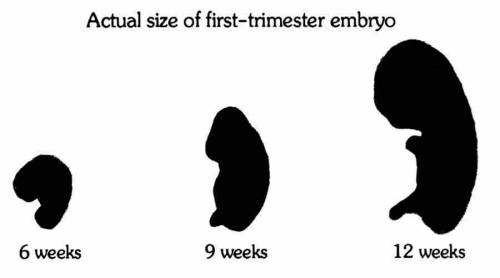One common point of contention in the abortion debate is the subject of informed consent. Members of the Prolife faction have introduced legislation to make sure that a woman is well-informed before her abortion. Prochoice activists claim the laws are not needed and are demeaning towards women, or even a thinly veiled attempt to make abortion more difficult for women to attain. One comment from a prochoice publication is below:
“The Pennsylvania Abortion Control Act went into effect on March 20, 1994. For the past six years, health centers that provide abortion services and the lawyers representing them have been fighting the provisions of the law. What does the law provide? Women seeking an abortion must be told by a physician at least 24 hours prior to the procedure the nature of the procedure and the probable gestational age of the fetus. Women must also be told that materials are available describing fetal development and listing for agencies that offer alternatives to abortion....What we must do now is make sure that our Representatives know how strongly we feel about the law. Call them, write to them! Let them know how burdensome these regulations are. Vote for prochoice candidates....” - Elizabeth Blackwell Health Center for Women newsletter, April 1994

Here is a drawing distributed in at least one abortion clinic, put out by the NAF, National Abortion Federation. The members of NAF are abortion providers—people who know what a fetus looks like. If they wanted to be truthful, they could easily produce accurate information. Note: The drawings are enlarged.

On the left is a picture of a six to seven-week-old embryo taken during surgery for an eptopic pregnancy—one that developed in the fallopian tubes.

And a picture of a nine week old fetus—note presence of fingers and toes (right).

And a 12-week-old fetus/unborn baby
There have been numerous testimonies, articles, and evidences given to support that at least some abortion providers have not been honest with their patients while ‘counseling’ them. Allegations of bias or outright lying to “sell” abortion were admitted to by some of the abortion providers leaving the field and occasionally even by abortion workers currently in the field.
Some examples follow.
“The fetus actually looks like a baby, only it doesn’t have any fat. We’ve noticed that very young patients are more apt to ask the sex, and be curious about what it looks like. We discourage it. And, we’re supposed to have a policy that we’re not going to tell the sex....” - Dora Greenwald, M.S.W., Clinic Worker
”It is when I am holding a plastic uterus in one hand, a suction tube in the other, moving them together in imitation of the scrubbing to come, that woman ask the most secret question. I am speaking in a matter-of-fact voice about ‘the tissue’ and ‘the contents’ when the woman suddenly catches my eye and says ‘How big is the baby now?’ These words suggest a quiet need for definition of the boundaries being drawn. It isn’t so odd, after all, that she feels relief when I describe the growing buds bulbous shape, its miniature nature. Again, I gauge, and sometimes lie a little, weaseling around its infantile features until its clinging power slackens.” - Sallie Tisdale, Clinic Worker
“Counselors are just to give the appearance of help...[They] think of themselves as company for the women.” -Abortion Counselor
“I have never yet counseled anybody to have the baby. I’m also doing women’s counseling on campus at Albany State, and there I am expected to present alternatives. Whereas at the abortion clinic you aren’t really expected to.” - Abortion Counselor
“Vital signs should be observed regularly, and a Doppler [for listening to the fetal heartbeat] inaudible to the patient should be used at intervals to determine the presence or absence of fetal heart tones...This [informed consent] is a controversial area, but most professionals in the field feel that it is not advisable for patients to view the products of conception, to be told the sex of the fetus, or to be informed of a multiple pregnancy.” - Dr. Warren Hern, Abortionist
 “Sonography in connection with induced abortion may have psychological hazards. Seeing a blown-up, moving image of the embryo she is carrying can be distressing to a woman who is about to undergo an abortion, Dr. Sally Faith Dorfman noted. She stressed that the screen should be turned away from the patient.” - Editorial on Abortion
“Sonography in connection with induced abortion may have psychological hazards. Seeing a blown-up, moving image of the embryo she is carrying can be distressing to a woman who is about to undergo an abortion, Dr. Sally Faith Dorfman noted. She stressed that the screen should be turned away from the patient.” - Editorial on Abortion
Sonogram, First Trimester (left)
“I was trained by a professional marketing director in how to sell abortions over the telephone. He took every one of our receptionists, nurses, and anyone else who would deal with people over the phone through an extensive training period. The object was, when the girl called, to hook the sale so that she wouldn’t get an abortion somewhere else, or adopt out her baby, or change her mind. We were doing it for the money.” - Nina Whitten, Chief Secretary at a Dallas Abortion Clinic under Dr. Curtis Boyd
“They [the women] are never allowed to look at the ultrasound because we knew that if they so much as heard the heart beat, they wouldn’t want to have an abortion.” - Dr. Randall, former Abortionist
“If a woman we were counseling expressed doubts about having an abortion, we would say whatever was necessary to persuade her to abort immediately.” - Judy W., former office manager of the second largest abortion clinic in El Paso, Texas
“We tried to avoid the women seeing them [the fetuses] They always wanted to know the sex, but we lied and said it was too early to tell. It’s better for the women to think of the fetus as an ‘it.’” - Norma Eidelman, Abortion Clinic Worker
“When discussing the sonogram, you are supposed to tell the client that it is a measurement as far as the pregnancy is concerned, but not a measure of the fetal head or anything like that.” - Rosemary Petruso, on her training to be an Abortion Counselor
“Sometimes we lied. A girl might ask what her baby was like at a certain point in the pregnancy: Was it a baby yet? Even as early as 12 weeks a baby is totally formed, he has fingerprints, turns his head, fans his toes, feels pain. But we would say ‘It’s not a baby yet. It’s just tissue, like a clot.’” -Kathy Sparks
“When I first started working there [at the clinic], I had to sit and listen to women answering the phone for at least a month before they would allow me to answer the phone. We had to know exactly what we were doing when we were talking to these women. We had to find out very quickly what their problem was, play on that and get them in the clinic for an abortion. We were very good salespeople.” - Joy Davis
“In fact many women will come to me considering abortion, and I have been personally told that I am to turn the monitor away from her view so that seeing her baby jump around on the screen does not influence her choice.” - Shari Richards
Sonogram- First Trimester (right)
“When a girl called to make her appointment, we’d work her in as soon as possible. If she called on Tuesday, we’d have her in no later than Friday. We wanted to avoid a long waiting period where she’d have time to think about it. First she would fill out her forms, and then talk with a counselor...The counselors were trained in what areas to cover and which to avoid. They’d say, “I know this is a terrible situation you’re in. What can we do to help make this better for you? Yeah, it doesn’t sound like you’re ready for a pregnancy right now.” Their task was to keep the machinery moving—to get the woman into the procedure room as quickly as possible.” - Anonymous Clinic Worker
“There was a public health center in a town not far from Denver and they sent a lot of girls to us. They told us they did all the counseling. We weren’t allowed to counsel them or even ask them about birth control. We couldn’t even tell them what could happen during the abortion. Nothing. If we tried to discuss alternatives, we would get in trouble with the doctor because then the health center would threaten to send their business elsewhere. All we did was find out how far along they were, tell them when they were going to be finished, get their money, do the abortion, and send them home.” - Sam Griggs, Registered Nurse
In his article “Abortion Wars” from the Ottawa Citizen, Leonard Stern quotes Canadian physician Eloise Jones:
After having recommended some 500 abortions in the 1970s (back in the days of the hospital committees), the Canadian physician Eloise Jones once remarked, ``Almost all the women applying for therapeutic abortion repeated the words, `Oh it’s not a baby, there’s nothing formed, it’s only a blob of tissue,’ or `It’s mostly placenta—nothing much to it,’ or `I certainly don’t have any feelings for it.’ Those words imply ignorance, and constitute wishful thinking, the desire to escape reality.’’
He also went to another clinic and spoke to a worker named Ms. Joan Wright after an unsuccessful attempt to interview a doctor on staff. He asked Ms. Wright:
“...is there anyone who can talk about abortion counseling?” There was a long pause. She didn’t understand ”... Don’t you have people who explain to clients what their options are?’’ ” Women are considered intelligent enough to make the decisions themselves,’’ she snapped.
Abortion clinic counselor Sylvia Hampton discusses counseling sessions with abortion patients’ companions. She acknowledges the truth about fetal development if directly confronted, but tries to redirect:
“Sometimes, they [the partners of those having abortions] would say ‘Have you ever seen the abortion afterward?’ and I would say, ‘Yes, I have.’ Then they would say, ‘Well, what does it look like?’ And I would say, ‘Well, it depends on the stage of the pregnancy. ‘‘Does it have little feet and a heartbeat?’ And I would say, ‘Yes, at the early stages it does. But you have to have a magnifying glass to see it. And that’s beside the point. The point is that this is a developing embryo that is going to become a child, a teenager, an adult. Is this what this woman wants? Is this what this woman is ready for?....’I would kind of put it back on them: Yeah, it is a developing human being, but why isn’t she carrying it to term? And then they would start to talk about that.”
“Abortion is a hard enough thing for any woman to decide without the torture of seeing the baby on an ultrasound screen.” - Dr. L. Lacroix, Planned Parenthood, Kelowna, B.C
“I have seen hundreds of patients in my office who have had abortions and were just lied to by the abortion counselor. Namely ‘This is less painful than having a tooth removed. It is not a baby.’ Afterwards, the woman sees Life Magazine and breaks down and goes into a major depression.” - Psychologist Vincent Rue
The Reproductive Health Access Project gives “Pregnancy Options Counseling Points for the Ambivalent Patient.” Here are some of the points:
Normalize feelings of ambivalence.
Acknowledge common feelings such as shame, disappointment, guilt and regret.
Reframe the situation—she may be making the most responsible decision by NOT continuing the pregnancy.
Be conscious of time—you do not need to know everything about the patient to help her make a decision.
Refer to the pregnancy, not the baby.
Elucidate that the patient’s choice not to be a mother now does not mean she is choosing not to be a mother in the future.
One book documents two conversations between abortion clinic staff and reluctant abortion patients. Here is one:
“Peggy’s (the patient’s) mind is off on a different track.”Is it true that at six weeks it has a heartbeat?” Carye (the counselor) says nobody is sure exactly when the heart begins beating, and tries to deflect that concern. “This pregnancy and you are the same thing,” she adds, explaining to Peggy that prior to twenty-four weeks the fetus cannot survive outside her womb.”
In this second passage, a young woman in her fourteenth week of pregnancy named Tiffany does not want to abort. This is the clinic counselor speaking:
“I’m not here to change your mind. I’m not here to force your opinion. But I’m sitting here seeing this beautiful young woman with her whole life ahead of her, and you have so many other things you can do right now. Why don’t you go ahead with your dreams and have kids later?” Tiffany had no answer so Anneke continued, “We’re always here for you.”....Before ending the session Anneke left Tiffany with some figures that she recently had learned from Carye: One in ten high school girls who become pregnant finish high school, and one in ten thousand girls who have babies during high school finish college. And a third statistic: Over 80 percent of the men in this country don’t pay their child support. “The statistics are stacked against you,” Anneke said.”(21)
 Tiffany did, reluctantly, agree to an abortion, and had one even though her boyfriend, who had proposed, went to the clinic in attempt to persuade her not to. He was thrown out by clinic staff, who called police, although the author of the book, who was a witness to these events, made no indication that any violence or threat of violence was present.
Tiffany did, reluctantly, agree to an abortion, and had one even though her boyfriend, who had proposed, went to the clinic in attempt to persuade her not to. He was thrown out by clinic staff, who called police, although the author of the book, who was a witness to these events, made no indication that any violence or threat of violence was present.
14-week unborn, similar to the one Tiffany aborted (right)
“I was totally uninformed of available alternatives to abortion. I never recommended adoption or keeping the child. Furthermore, I was completely unaware of the medical facts, including the development of the fetus. I received no training in factual matters—my job was just to keep women happy and make sure they went along with an abortion.” - Abortion Clinic Worker
“Many women could not afford to have babies, so we would use examples—like the price of babies’ shoes, the price of clothing, how much it cost to raise a baby. If they weren’t finished with their education, the hindrance it would have on their education, how would they find a baby sitter, who was going to take care of that baby for them? We would find their weakness and work on them...All they were told about the procedure itself was that they would experience slight cramping similar to menstrual cramps, and that was it. They were not told about the development of the baby. They were not told about the pain the baby would be experiencing or the physical effects or the emotional effects it would have on them. They had no idea who was going to be there to help them when they fell apart afterwards...Some of the women were a little apprehensive about it. We were told that in explaining to them we could never use the word “babies.” It was always tissues, tissues of cells, or clusters of cells or products of conception....
“The women were never given any type of alternatives to the abortion. It was just automatically assumed that they knew what they wanted. They were never told about adoption agencies. They were never told about people out there who were willing to help them—to give them homes to live in, to provide them with care and even financial support. The euphemisms that are used—clusters of cells, products of conception, or just plain tissue—are all lies.” - Deborah Henry, Former Clinic Worker
“In my opinion, the most important part of this particular abortion clinic was the counseling. I was able to sit with one particular worker who had eight years of college; she was so very good. She could sit down with these girls during counseling and she could cry with them at the drop of a pin. She would immediately start drawing them out, asking them all kinds of good questions. She would find out what their pressure point was. What was driving them to want to abort that child, and whatever that pressure point was, she would magnify it. If it was the fact that her parents were going to ‘kill’ her, and she didn’t know how she was going to be to tell her parents; then the counselor would proceed by telling her, you don’t have to do this; that’s why abortion is here, we want to help you; this is the answer to your problems. Oftentimes, if it was money, she would tell them how much baby items cost...the counseling at this particular abortion clinic was so effective that 99 out of every 100 women would go ahead and abort. So that’s very effective counseling.” - Kathy Sparks, Former Clinic Worker
“How many of you have seen a number, unsolicited, that you think you could call that said, “Problem Pregnancy,” “Abortion Information” or “Pregnant?” in your area where you think you could call for abortion information? Let’s talk about those kids when they find out that they are pregnant. They may not want an abortion: they may want information. But when they call that number that’s paid for by abortion money, what kind of information do you think they’re going to get? Let’s remember, they sell abortions. They don’t sell keeping the baby. They don’t sell giving the baby up for adoption. They don’t sell delivering up the baby in any form. They only sell abortions...This counselor is paid to be this girl’s friend. She is paid to be the authority for the girl. She is supposed to seduce her into a friendship of sorts to sell her the abortion. Every problem this girl has: I don’t want to tell my parents. You don’t have to tell your parents. They don’t have to know. You’re old enough to come in and have it without them knowing. And then the money, and they ask them to go get their money and pay the people back in a year....They tell the counselors, and I told the counselors, not to rock the boat; not to answer any questions that they didn’t ask.” - Carol Everett, former owner of 2 abortion clinics and director of 4
“The information provided [by abortion providers] is often unreliable or exaggerated. Consider this text from a “frequently asked questions” Web site - “Making Your Decision” - published by Early Options, a Brooklyn physician’s office:
 “It might help you to know that if you are in the early stages of pregnancy, you are not yet carrying a fetus or baby. In fact, if it has been less than 7 weeks since your last period, your pregnancy consists of nothing visible to the eye except a tiny, empty sac in your uterus. By 8 to 9 weeks, your pregnancy is the size of a pea.”- Article on Abortion Information
“It might help you to know that if you are in the early stages of pregnancy, you are not yet carrying a fetus or baby. In fact, if it has been less than 7 weeks since your last period, your pregnancy consists of nothing visible to the eye except a tiny, empty sac in your uterus. By 8 to 9 weeks, your pregnancy is the size of a pea.”- Article on Abortion Information
7 week unborn (right)
“If you can’t sell abortions over the phone, you will not last.” -Hellen Pendley, former owner-director of an abortion clinic
“Professionally, we are obliged to give accurate, current and factual information to our patients to assist them in making a fully informed decision. This is the basis of informed consent. Yet nurses are advised to avoid showing pictures which explain the development of the unborn child because it may make them feel guilty, even though it is often our patients who later question us as to why we did not give them more information.” - Barbara Docherty, Practice Nurse Educator
In one abortion clinic, a worker named Mira is quoted saying: “We don’t counsel women…we assume if a woman says ‘I’m here to have an abortion’ that she’s thought about that.” The interviewer herself then says: “Several health workers pointed out that they occasionally dealt with ambivalent clients, even though Center methods were predicated on not probing women for doubts.”
“There are some women who are like “I don’t know what I want to do,” and the system…is we assume women are totally clear in their decision the minute they walk in the door. If they’re not, we have to back up…And that’s challenging from a….workflow point of view.” - Greta, Clinic Worker
Are some women ambivalent when they come to an abortion clinic? In the experience of some abortion providers, the answer is yes.
At Newsreview.com “Inside an Abortion Clinic” clinic counselor “Laura” says: “Maybe 30 percent [of the women] are kind of talking through doubts, maybe 5 percent go away.”—This was posted on January 29, 2004.
Another quote by an abortion worker at the blog “Abortion Clinic Days” under the heading “Sending her Home” (May 2006) is as follows: “I have also seen many times a woman changing her mind a number of times.”
“Sometimes it’s `the pregnancy’, sometimes it’s `the baby’. The challenge is gaining people’s trust in a very short space of time.” - Abortion clinic counselor “Poppy”
A D & X or “Partial Birth Abortion” is a procedure in which a living unborn baby in the second or third trimester (similar in age to the one shown above) is delivered almost entirely from the woman’s body. The abortionist holds the head inside the mother and then punctures the baby’s skull with a syringe or pair of surgical scissors (depending on the age of the fetus) then drains of suctions out the brain contents. One abortionist who performs this procedure, was asked if she told her patients the details of what she was going to do to them and their baby. She replied: “I do not usually tell patients specific details of the operative approach.” Carolyn Westhoff, abortion doctor, quoted from the transcripts of National Abortion Federation vs. Ashcroft: US District Court, Southern District of NY, Honorable Richard Conway Casey Judge. In the same court case, abortionist Casey Hammod was asked whether he told patients the exact nature of the procedures he performs on them. He said yes, but then went on to say: ”Keep in mind a lot of my patients are emotionally quite fragile so we don’t have to bring up the terms—we don’t have to go into every gory detail about what we are doing... “ Are women to emotional and fragile to be told the truth about an elective medical procedure? Or does a woman have the right to know exactly what is going on in her body?
“We were hiding…some pieces of the truth about abortion that were threatening. Abortion is a kind of killing and most women seeking abortion know that.” - Charlotte Taft, Former Clinic Administrator
In one article, abortionist William Harrison states: “I am destroying life.” Though he does go on to say, “It’s not a baby to me until the mother tells me it’s a baby.” This is all he tells the patient: “You may feel some cramping while we suction everything out.”
Abortionist Dave Turok feels that women are too fragile and delicate to know the facts about whether the fetus feels pain. Obviously, women are too emotional to make an informed choice. ”Telling those women their fetuses feel pain is heaping torment upon torment. These women have real pain. They did not come to this decision easily. Creating another barrier for them to get the medical care they need is really unfair.” Is it more traumatic for a woman to know her baby feels pain before chooses to undergo an abortion? Or is it better for her to find out this fact somewhere else after the abortion is done and it’s too late?
In many states, there are no laws governing what clinics must tell patients about abortion medical risks, leaving the clinics free to withhold this information from prospective patients. A bill was proposed to mandate that information about the physical and mental complications of abortion be given to women. Nearly all prochoice organizations opposed this legislation, as did abortionists. Here is a quote by Joyce Tarnow, owner of an abortion clinic in Florida:
‘‘We have always had informed consent, that is that they understand what an abortion is: that it’s a termination of pregnancy, This (pamphlet mandating clinics tell patients the risks of abortion) is just an anti-abortion campaign that’s gone too far.’’
Dr. Christensen performs around 3,000 abortions a year in his clinic. An article describes how he responds to an informed consent law:
He said he decided to put it [the state mandated information] on videotape so he could see patients while others viewed his lecture. And, he made a few of what he said he felt were corrections. While the state form says ‘‘unborn child,’’ he says ‘‘the developing pregnancy.’’….’’This is all basically harassment,’’ he said.
Dr. Christensen does say that one out of every ten women leaves after hearing the taped information.
The previous information was compiled by Sarah Terzo. You may view her website which is complete with documented footnotes.




